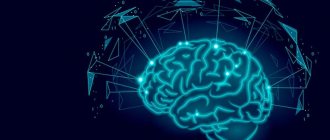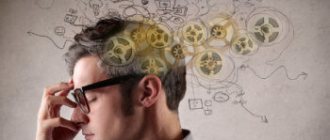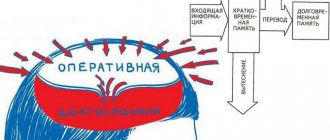Today, almost everyone has a computer. Just for the sake of curiosity, look at how much memory it has. On average, the RAM is 4-8 gigabytes, the hard drive is from 500 to 2000 gigabytes. If we compare the human brain with this machine, it can store 1 million gigabytes of information. This fact alone indicates the uniqueness of this mental process. Memory is considered one of the most studied areas, but it still holds many secrets, which many minds continue to work to uncover.
What it is
Memory is one of the highest mental functions (along with perception, imagination, thinking and speech), responsible for the accumulation, preservation and reproduction of acquired knowledge and skills. In psychology, this is the foundation of personality development, without which it cannot fully develop. It helps a person navigate time and space, build relationships, and accumulate experience.
However, the definition of this concept is interpreted by different theories with slight deviations:
- associative theory (G. Ebbinghaus, A. Pilzecker): this is the establishment of associative connections between memorized and reproduced material;
- behaviorism (V. Bekhterev, D. Levy): this is a process of continuous training to memorize information through constant repetition;
- cognitive psychology (D. Miller, D. Sperling): this is a complex of interconnected blocks that process information;
- activity approach (A. Leontiev, S. Rubinstein): this is a link that connects a person with the world around him through a mnemonic image (representation).
Despite such different approaches to the formulation of the term, psychological schools and theories do not dispute the physiological basis of memory. For absolutely everyone, memory is a function of the brain, which means that it can be developed, trained, impaired, damaged. It can be corrected using various techniques and therapeutic practices.
Interesting fact. For a long time, a theory was widespread in psychology according to which a person is born with a completely empty hippocampus. However, recent research has shown that it begins to record certain events when the embryo is only 20 weeks old in the womb!
Books on memory development
- Andreev O. A. Memory development technique. Self-instruction manual.
- Arden D. B. Memory development for dummies.
- Bukin D. Development of memory according to the methods of special services.
- Buzan T. Guide to the development of memory and intelligence.
- Grace N. How to Help Yourself (KPSS). Techniques for developing memory, attention and speech.
- Dumchev A. Remember everything. A practical guide to memory development.
- Lorraine G. Development of memory and ability to concentrate.
- Navarro A. Memory serves. Tasks and puzzles for the development of intelligence and memory.
- Pugach Yu. K. Development of memory. Reception system.
- Khoroshevsky N.I. Modern methods for the development of memory and thinking.
There are many techniques on how to effectively and quickly develop memory in order to remember as much information as possible and reproduce it accurately. All you need is systematic training and strict adherence to the goal. Believe me: such training will not only radically change your quality of life for the better, but will also protect you from many problems in old age.
Psychology of memory
As already mentioned, despite a large amount of research, there are many blind spots. In particular, ambiguities relate to the physiology and so-called “chemistry” of this process.
How it works
From an anatomical point of view, different parts of the brain are responsible for mnemonic abilities.
The hippocampus (temporal sections of the hemispheres) is a paired formation that forms emotions, maintains attention, and is responsible for the transition of information from short-term memory to long-term memory. Psychologists jokingly call it the body's search system. In the left hemisphere, it forms facts and verbal information, and in the right - an autobiography according to time and topics. Switches off in a state of alcoholic intoxication, passion or strong anger. Not responsible for procedural memory. When this part of the brain is injured, a person continues to remember previously acquired skills (driving a car, repairing equipment).
In Southern California, they created a so-called “memory prosthesis” - a silicone hippocampus, which is successfully implanted into people suffering from amnesia.
The parietal cortex is responsible for playing musical instruments.
From the point of view of neurochemistry, mnemonic abilities are responsible for:
- acetylcholine is a hippocampal neurotransmitter that transmits signals from neuron to neuron;
- brain metabolism;
- protein synthesis necessary to activate neural circuits;
- genes that determine their structure.
When reproducing information, neurons turn to the synaptic bridge that was built with the help of associations, repeated repetition, or a traumatic factor earlier.
Which parts of the brain are responsible for memory and which biochemical processes influence it are still being clarified. Here are just a few research results:
- actin is a protein that forms drug addiction: when it is destroyed, patients get rid of harmful memories;
- the amygdala is the part of the brain responsible for fear memories;
- protein molecule protein kinase M-zeta - instantly erases even the most well-fixed memories from long-term storage;
- CPEB oligomers are molecules that in neurobiology are called an analogue of the Ctrl+V keyboard shortcut, only in the nervous system: thanks to their constant regeneration, a person is able to remember even what happened many years ago;
- PPAR-alpha protein is a protein that is used by the liver to burn visceral fat in the abdomen, by the hippocampus to improve the reproduction of information, so poor memory and excess weight are interrelated;
- genetic modification and the implantation of optical fibers into the brain led to the formation of a “false” memory - a person experiences something that never actually happened to him.
And this is only a small part of the scientific research that is being conducted in this area. The biggest gap is long-term memory. It is still unknown where exactly her storage facility is located.
How does it work
Stage I - short-term: fixation
Short-term memory is responsible for information remembered right now. It concerns those everyday moments when we need material within a minimum amount of time. For example, we were given a phone number and we type it on the screen. Or, going to the kitchen, we go through in our heads what needs to be done: spread a sandwich, pour tea, have breakfast. You cannot be distracted here, since fixation has not yet occurred, and everything can simply disappear from your head.
Stage II - long-term: fixation
If we dialed a phone number and immediately forgot about it, this information will be lost. But, if you repeat it several times, then try to reproduce it an hour later, half a day, a day later, then it will become the property of long-term memory. However, it also works differently, depending on the goal setting (why we memorized this material).
Stage III - Procedural: Storage and Reproduction
If one of the fixed skills is brought to automaticity and repeated day after day (or less often, but still regularly), the body will unconsciously reproduce it. This applies to the ability to drive a car, play the violin, etc.
An example of how it works. When riding a bicycle in the brain, clusters of neurons reproduce once formed synapses (bridges). They allow you to almost unconsciously, “automatically,” maintain balance, turn the pedals, and slow down. These are implicit memories that allow you to live in the present based on past experiences.
Stage III - Declarative: Storage and Reproduction
Unlike procedural memory, declarative memory is the conscious reproduction of necessary information. For example, a person remembers the plot of a movie to discuss it with a friend, or a romantic story of meeting a girl.
An example of how it works. You were asked how you learned to ride a bike. With the help of associations, neurons recreate images that once had an emotional impact on you. You begin to remember details: the weather, the people, the clothes you were wearing. These are explicit memories that require some effort. They are clearly recognized as past experience.
Stage IV - semantic: storage and reproduction
Long-term declarative semantic memory stores names, place names, terms, and theoretical background. Everything related to the verbal system and semantics. Usually, to memorize them, either repeated repetition (so-called cramming) or the associative method is used.
Stage IV - episodic: storage and reproduction
Long-term declarative episodic memory stores stories, events, and experiences. It is often involuntary. The emotional component is important here. Often people want, but cannot forget some life shocks, since they are psychologically traumatic. This is how autobiographical memory is formed and begins to work.
The diagram of how memory works can be roughly depicted as follows:
How it develops
Since memory is a function of the brain, it can be trained and developed. For some it is good, for others it is impaired and thereby causes many problems. Its formation depends on four main factors.
Factor 1. State of the nervous system
Good memory occurs in those whose nervous system is characterized by such parameters as:
- the strength of nervous processes - an adequate response to a powerful stimulus from the outside;
- balance - balance of excitation and inhibition processes;
- mobility - their rapid change;
- dynamism - their rapid generation in the process of forming conditioned reactions (learning);
- lability - the rate of emergence and attenuation of nervous processes;
- activation - individual abilities to take advantage of the processes of excitation and inhibition.
Factor 2. Repeatability of contact with the stimulus
Repetition is a fundamental method for developing mnemonic abilities in psychology that all people can master. When a person regularly reproduces the same information, neural signals pass along the same synaptic bridge, which becomes stronger and stronger each time.
Kinds:
- active repetition, when memorized information is not only recorded, but also realized (thinking processes, logic, associations, past experience are involved);
- retelling, when the material is not reproduced verbatim, implies partial use of active repetition (in order to retell the text, you first need to comprehend it);
- learning by heart - literal reproduction of material; associative connections can be used, but most often fixation occurs automatically.
Factor 3. Motivation to remember
One of the most obvious factors influencing the development of memory, which is closely related to the emotional component.
Example. A student learns chemical reactions for an ordinary lesson, not being sure what he will be asked. He will be distracted and remember the material mediocrely (with errors or incompletely). But, if he sits over the same chains before a test in which they will definitely be included, due to increased motivation he will learn them much better.
Factor 4. Age
Little children do not know how to use their mnemonic abilities 100%. In children they are involuntary. They easily remember what interests them, what they learned during the game and is connected with the emotional sphere. They begin to develop more seriously only in elementary school, when you have to make an effort and set a goal for yourself in order to fix something.
Over time, neural connections and synaptic bridges become stronger - memory reaches its peak development, according to research, by the age of 25. This does not mean that after this it goes down. Rather, it resembles a straight line. If a person trains it, it will only improve; if not, after 50 years there will be disturbances and problems.
This is interesting. People take photographs of themselves, loved ones and places they have visited to remember certain moments. However, recent studies have cast doubt on this fact. It turned out that those people who take pictures quickly erase the captured moments from their memory. They do this involuntarily - the brain decides everything for them: why litter the storage if there is a visual reminder in the form of a photo, and the information is erased.
Stages of information processing when memorizing
If we talk about the structure and mechanism of perception, analysis and sending for storage into memory of any information received, then this happens at the following levels.
- Sensory processing of any data. Fractions of a second are allotted for this period. Everything is remembered briefly and put aside for longer storage only if it has been analyzed as valuable.
- At the next stage, the received data is sent for storage. If they are used in the very near future and a person uses them almost immediately, then this type is called short-term. This includes, for example, orders at work that need to be completed during the current working day.
- Next comes long-term or long-term. This place is a repository for everything important that will be used over a long period of life. As a rule, this includes all acquired skills and life experience, knowledge and abilities, memories and impressions.
- RAM is similar to internal computer memory. This type is used when you need to work with small amounts of information over a long period of time. Despite its similarity with short-term, there are still certain differences between them.
- Tertiary memory refers to long-term memory. Most often used to store language arrays.
Tweet Pin It
Properties
Human memory has certain properties on which its quality and volume depend.
Absent-mindedness
If attention is focused on one thing, recording and reproducing information on a topic that is not of interest will be impossible.
Examples. The driver is in a hurry on the road, the weather conditions are bad, the emergency situation has increased, he tries to maneuver in such a way as to avoid an accident and get to the appointed place at the appointed time. At that moment someone calls him. Most likely, after he hangs up, he won’t even remember who called him and what they said.
Helpful advice. At moments when maximum concentration of attention is required, you cannot be distracted by other events and emotions, much less set yourself the goal of remembering information that is not relevant at that time.
On the tip of the tongue
This property most often manifests itself in older people, although almost everyone was hostage to such a situation. When one of the synaptic bridges is not used for a long time, neural connections weaken. It does not disappear, but seems to be stored under a layer of snow. When it is necessary to reproduce information associated with it, neurons look for it, but do not find it immediately.
In practice, it looks like this: we know exactly the last name and first name of a given writer, but we just can’t remember. Often the opposite situation arises: you’ve already heard this word somewhere, but you can’t remember where exactly.
Helpful advice. Associations will become a router for finding synaptic bridges “under the snow” - master mnemonics.
Sleeper effect
It is human nature to often make mistakes about the source of the information he has. We think we know this term because we learned it during our student days from a textbook, the accuracy of which no one doubts. In fact, it turns out that they heard it briefly on TV, and besides, the accuracy of the wording left much to be desired.
Helpful advice. Double-check information that relates to long-term memory.
False memories
If all the people who are eyewitnesses to the same event say that something happened that actually did not happen, the person will repeat the same thing after them in 90% of cases. At the same time, he will be sure that this really took place, he just forgot the details.
Helpful advice. Learn to trust yourself and not follow the crowd just because everyone says so.
Stereotypical consciousness
Memory adapts to the stereotypes of human consciousness. If the cult of the female figure “90-60-90” is popular in modern society, men remember girls with this particular physique better. The racist will be sure that the crime was committed by a man of the Negroid race and will even go as a witness that he himself saw it, although in reality nothing happened.
Helpful advice. Develop self-awareness, free from the framework, conventions and stereotypes of society.
Forgetfulness curve
Everyone dreams of having a phenomenal memory and remembering to the smallest detail the events of long-ago days. Many people get upset when they can’t remember the name of their deskmate in 1st grade. In fact, the brain is an incredibly smart device, and it simply erases information that is not only outdated and never reproduced, but also completely useless.
Helpful advice. Don’t be upset if some moments from the past are forgotten forever: it means that the brain considered them useless.
Reconsolidation
Under the influence of emotional and stress factors, the process of recording information occurs much faster and with better quality. That is why a person so often reproduces unpleasant moments - quarrels, conversations with the boss, humiliation.
Helpful advice. In order not to further traumatize your memory and not to clutter it with unnecessary and unpleasant information, try by any means to strengthen your nervous system and avoid traumatic situations.
Infantile amnesia
Guinea pigs remember everything they have been taught since birth. Human memory does not have this property. We reproduce only information that was received after 3 years. Psychologists still cannot find an explanation for this phenomenon.
Helpful advice. You can only come to terms with this. Or become a guinea pig.
Flashes
Sometimes a person remembers an event as vividly as possible: a wedding, a funeral, a trip. 5 years pass, 10, 20, and the memories remain just as clear and detailed. Unfortunately, this is a false picture. As studies have shown, 50% of information turns out to be incorrect, as it is embellished and made up at the time of reproduction.
Helpful advice. Try to avoid such outbursts. The less frequently you retrieve such information from storage, the more accurately you save it.
Obsessiveness
Sometimes it is difficult to free yourself from the obsessive memories that follow you: every now and then a divorce, a dismissal, or some offensive words come up in your memory. They can lead to depression and even suicide. This is evidence of psychological trauma.
Helpful advice. In such cases, you should definitely contact a psychologist. It is extremely difficult to free yourself from obsessive memories.
Psychologists and psychotherapists actively use all these properties of human memory in their work to help individuals overcome internal crises and get rid of traumatic moments forever. In ordinary life, knowing about them, you can do it yourself, taking into account the advice that was given for each of the features.
With the world - one by one. Scientists from Los Angeles claim that very soon it will be possible to transfer memories from one brain to another using RNA molecules. If you wanted to share your impressions and experiences with someone, you don’t have to tell them: your interlocutor will be able to experience them himself.
Functions
According to psychology, human memory is characterized by functions that form its basis. They resemble the actions that we reproduce with a regular USB drive.
Memorization/recording
USB drive: transfer information from one media to another (from one flash drive to another).
Memory: transferring material from a short-term perspective to a long-term perspective. First - filtering the necessary information (using the sensory system), then - processing it (multiple repetitions, associations and other methods). Building a new synaptic bridge, developing new neural connections.
Save/commit/archive
USB drive: click the “Save” button, close both media.
Memory: we make sure that we have memorized the material (repeated the poem learned by heart) and moved on to processing new information. From time to time it is necessary to return to the constructed synaptic bridge to ensure its strength. This is where semantic and episodic memory, discussed above, come into play.
Play/Extract
USB drive: at the right moment, turn on the USB drive, open the desired document and work with it.
Memory: in a literature lesson, we retrieve a poem learned by heart from long-term memory. After a signal to the brain, neurons turn to the desired synaptic bridge. The stronger it is, the faster the playback will be. To avoid mistakes, it is good to use “reference points” and associative links. How exactly to do this can be learned from the didactic theory of memory development and mnemonics.
Forgetting/deleting
USB drive: if the information on the flash drive is outdated or corrupted and we are sure that it is no longer needed, we delete it.
Memory: the brain does about the same thing. However, forgetting is not always due to the fact that some memories lose relevance and are unclaimed. The reasons can be different: for example, insufficient fixation (poorly remembered), age (in children and old people this happens involuntarily), lack of motivation.
There is an ambiguous opinion on this function of memory in psychology. A number of experts believe that it is negative, as it reflects a general deterioration of memory. The more material is forgotten, the less success you can achieve in your studies and career. Other scientists attribute positive properties to the process of removing information from storage. They compare it to spring cleaning: it frees up space for new impressions and facts.
Did you know that... the memories of the same event by different people will always differ from each other? Some people fix their attention on color perception, others on comfortable sensations, and others may even consider a security guard instead of a painting in a museum.
Selected recommendations
To increase the effectiveness of your training, follow these recommendations from neuroscientists:
- Explore new horizons.
- Visit as many new places as possible: exhibitions, museums, quests, panoramas.
- Learn and regularly perform one of the breathing exercises.
- Give your brain a good rest for 15 minutes every day. Dim the lights, turn on relaxing music and try not to think about anything.
- Move more. Play sports. Take a walk.
- Try to be outdoors more often. Ventilate the rooms you are in.
- Repeat important information that will be useful to you tomorrow before going to bed.
- Avoid lists (memorize information) and calculators (do calculations in your head).
- Read books, learn languages, memorize poetry.
- Use online trainers: Wikium, Zanimatika, B-trainika, Supermozg, BrainApps.
Kinds
In psychology, different types of memory are distinguished, and the classifications are based on different reasons.
By the nature of mental activity:
- motor (motor);
- emotional;
- semantic (logical);
- figurative;
- auditory;
- taste;
- visual (sensory, visual, photographic, spatial);
- tactile;
- social;
- eidetic.
By the nature of goal setting:
- arbitrary;
- involuntary.
By duration of information storage:
- ultra-short-term (iconic and echoic);
- short-term;
- operational;
- long-term.
To organize memorization:
- episodic;
- procedural (automatic).
For information reproduction tools:
- a person’s own internal memory (the so-called “RAM”), when a person uses only personal storage data and internal resources;
- external (reproduction occurs using photographs, videos, reminders, i.e. using external resources).
We talked in more detail about each type and the classification available in psychology in a separate review.
Keep in mind. For early risers, mnemonic abilities are most effective from 8 am to noon, for night owls - from 8 pm to midnight. They should memorize the necessary information (learn poetry, prepare for exams or reports) during this time period.
Physiology of the memory process
The ability to retain information is not unique to humans. Animals with a developed central nervous system can also remember and reproduce data (migratory birds know routes). The volume and duration of data storage depends on the number of nerve cells involved in the process.
Information recorded in short-term memory is transferred to long-term memory through a complex biochemical process. The neurons that make up the brain work like a recording device - they remember information and store it. Data is recorded not on individual neurons, but on a neural network - a stable collection of cells.
When a person remembers information, neurons become active. The data travels along the fibers and reaches the cluster. For information seen earlier, there is a ready-made accumulation in the brain. For data that a person learned for the first time, a new neural network is formed. There are connections between networks. A disruption in the functioning of at least one of them leads to the erasure of memories.
Manifestations
Psychologists compare memory in different people with fingerprints, arguing that it is formed and develops completely differently in each person. This is due to their individual characteristics.
Leading mental activity
First of all, personal manifestations of memory are determined by the nature of the leading mental activity, which has already been mentioned above.
Example. One driving training group included a kinesthetic, visual and auditory learner. The topic of the lesson is “How to cope with uncontrolled skidding on the road.” To learn (remember) the material that the teacher explains:
- a kinesthetic learner must get behind the wheel himself (at least in a training simulator) and repeat the algorithm of actions in a given situation with his own hands;
- Visual material is enough for the visual: a poster or video; recording the material will also be very useful;
- The auditor may not write anything down or even look at the board - he remembers the material with the help of his hearing.
Knowing his leading type of mental activity, a person can improve and speed up the memorization process several times. For this, a kinesthetic learner needs to touch everything, a visual learner needs to see, and an auditory learner needs to hear.
Memory quality
Depending on the degree of development of mental functions, each person’s memory will differ in quality. Everyone knows that it can be phenomenal, wonderful, mediocre and even bad.
It is considered good if it is characterized by such parameters as:
- high speed of memorization;
- long-term storage of information;
- accurate reproduction down to the smallest detail;
- readiness to recreate synaptic and neural connections for rapid reproduction.
All these parameters can be combined with each other in different ways, which also leads to either good memory quality or problems with it. For example:
- the most successful combination - high speed of memorization + slow forgetting;
- mediocre tandem - low speed of memorization + slow forgetting;
- partially successful combination - high speed of memorization + rapid forgetting;
- the lowest productivity of the couple is low speed of memorization + rapid forgetting.
Personality manifestations often include memory capacity. On the one hand, it really is not the same for different people. Some of the 20 dictated words can remember only 5, while others can accurately reproduce them all. However, psychologists say that this parameter is the same for everyone. It’s just that someone knows how to use the maximum of the provided volume, regularly training and developing their memory. Others do not consider it necessary to spend time on this, and as a result, they later complain that theirs is bad.
Wow! In India there are priests who know by heart all the songs of the Mahabharata (an ancient Indian epic) of 300,000 lines.
Problems and violations
If you have problems with the processes of remembering or reproducing information, you should not take it lightly. Many people do not go to the hospital only because they do not know which doctor treats memory. Most often this is a neurologist or neuropathologist. But with minor violations, you can come to a psychologist or psychotherapist for an initial consultation.
Memory diseases are diagnosed through various laboratory and instrumental studies. It is quite difficult to differentiate them from each other, since the classification is extensive.
Dysmnesia - quantitative disorders:
- hypermnesia - remembering unnecessary details;
- hypomnesia - partial reproduction of information from the past;
- anekphoria - inability to voluntarily remember;
- scotomization - selective forgetting of events in order to get rid of the pain they cause;
- palimpsests - loss of life during alcohol intoxication;
- retrograde amnesia - forgetting events up to a certain point;
- anterograde - forgetting events after a certain point;
- congrade - loss of life for the duration of a serious illness (coma);
- anterograde - complete loss of memory;
- fixation - inability to record and reproduce information;
- progressive - forgetting in the direction from a nearby moment to a distant one;
- stationary - permanent loss;
- regressive - gradual reproduction of forgotten material;
- retarded - confusion in chronology;
- affectogenic - due to a nervous breakdown;
- hysterical - forgetting certain moments.
Paramnesia - qualitative disorders:
- pseudo-reminiscence - lack of a sense of time boundaries (the past is perceived as the present);
- confabulation - false memories (replacement and fantastic);
- confabulation - a mild form of confabulation;
- cryptomnesia - appropriation of other people's memories;
- echonesia - exaggerated reproduction of information with emotional overtones.
Phenomena of false memories:
- jamais vu - the familiar seems unknown;
- deja vecu - new events seem to have already been experienced;
- deja antandu - new sounds seem familiar;
- jame antandu - familiar sounds seem unknown;
- jame su - the inability to remember firmly fixed material.
Luria classification:
- modal-nonspecific diseases - a violation of the auditory, motor, visual analyzers located deep under the cortex;
- modal-specific - violations of the surface zones of the analyzers: acoustic, visual-spatial, auditory-verbal, motor;
- system-specific - disorders of speech analyzers.
Violations also include:
- loss (partial and complete, sudden and gradual, progressive and regressive);
- failures (regressing and progressive, stationary and fixation).
Each disorder requires a separate diagnosis and course of treatment.
Let's debunk myths. Many people firmly believe that coffee improves mnemonic abilities and promotes faster memorization. In fact, it only temporarily allows you to concentrate your attention on something important.











